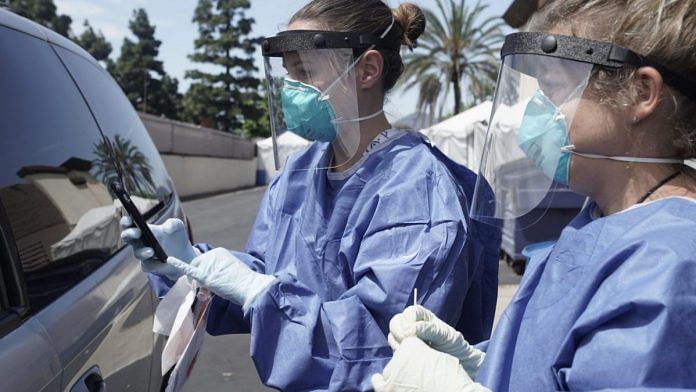
New Delhi: Healthcare workers are at the frontline battling the Covid-19 pandemic at great personal risk. However, a new US study has found that doctors are as much at risk outside the hospital as they are inside it.
The study by Northwestern University, published in the Open Forum Infectious Diseases journal Wednesday, found a crude seropositivity of 4.8 per cent among healthcare workers (HCW) in the state of Chicago. Seropositivity refers to the presence of antibodies against an infection.
But the researchers noted: “Studies of active and past infection, defined as presence of IgG antibodies to SARS-CoV-2 report that risks to HCW come from work-related exposures as well as from communities in which they live.”
According to the study, respondents who reported a “known out-of-hospital” exposure had a seropositive rate of 15 per cent. Furthermore, those who had reported to have a family member in their house who tested positive reported a seropositive rate of 54.8 per cent.
Seropositivity among different age groups
The study included 6,510 healthcare workers. Of these, 1,794 were nurses and 904 were administrators who did not have to face patients. Women accounted for 79.4 per cent of the study participants, while 74.9 per cent were white, 9.7 per cent were Asian and 7.3 per cent were Hispanic.
According to the research, participants aged 18 to 29 years had higher seropositive rates than older age groups. Hispanic participants had the highest prevalence rate of 9.6 per cent.
“There were no significant differences in the seropositive rates across gender or self-reported history of diabetes, hypertension and obesity,” the study noted.
Seropositivity in occupational groups
The study also assessed prevalence of seropositivity across occupational groups.
Those healthcare workers involved in support service (like food services, patient transports) had a prevalence of 10.4 per cent while 10.1 per cent seropositivity was recorded in medical assistants.
Nurses and respiratory technicians recorded a seropositivity rate of 7.6 per cent and 9.3 per cent, respectively. Hospital administrators recorded a seropositivity of 3.8 per cent and physicians had 3.3 per cent seropositivity.
Among specialised doctors, surgeons recorded a prevalence rate of 6.4 per cent, anaesthesiologists had 6.0 per cent. It was 4.3 per cent for emergency medicine, 2.9 per cent for medicine and family medicine, and 0.5 per cent for paediatrics.
“Nurses, medical assistants, and support services workers were high risk for SARS-CoV-2 infection. However, of those groups, only nurses had higher odds ratios for seropositive status after adjustment for differences in demographics and rates of out-of-hospital exposure between occupational groups,” the study said.
It also suggested that the higher seropositivity rates among medical assistants and support service workers may also be driven by ‘exposures that occurred’ outside the hospital.
“Healthcare works are at risk for SARS-CoV-2 infection from longer duration exposures to people infected with SARS-CoV-2 within healthcare settings and their communities of residence,” the study concluded.
Subscribe to our channels on YouTube & Telegram
Why news media is in crisis & How you can fix it
India needs free, fair, non-hyphenated and questioning journalism even more as it faces multiple crises.
But the news media is in a crisis of its own. There have been brutal layoffs and pay-cuts. The best of journalism is shrinking, yielding to crude prime-time spectacle.
ThePrint has the finest young reporters, columnists and editors working for it. Sustaining journalism of this quality needs smart and thinking people like you to pay for it. Whether you live in India or overseas, you can do it here.